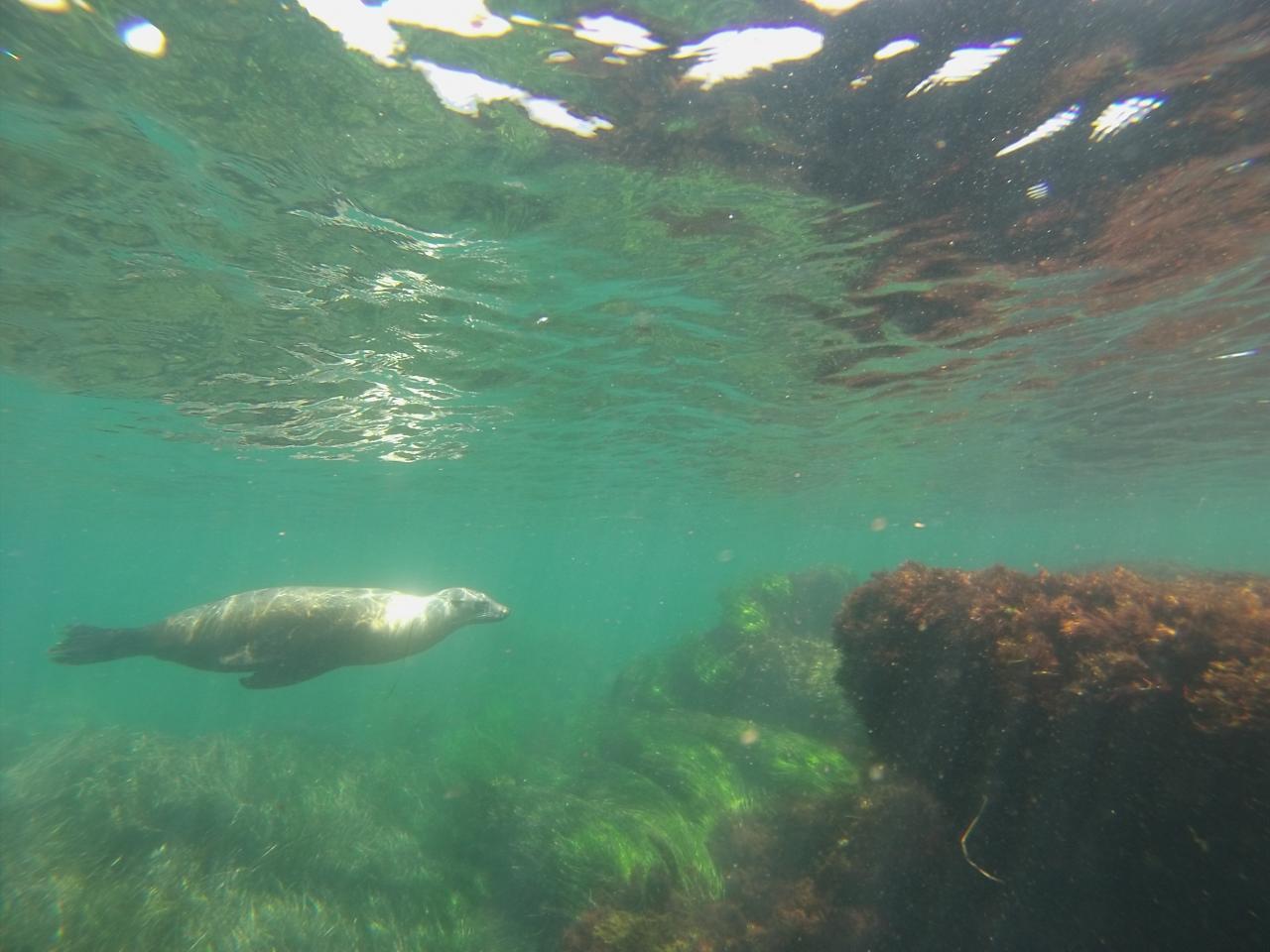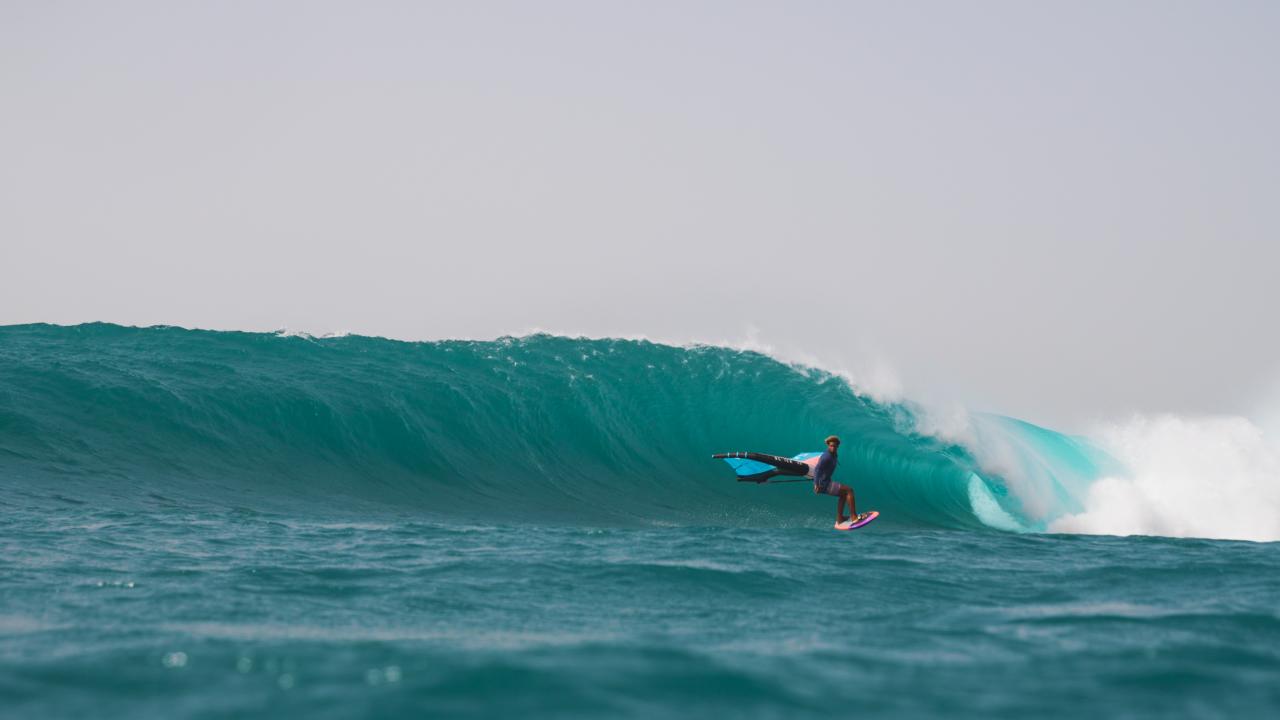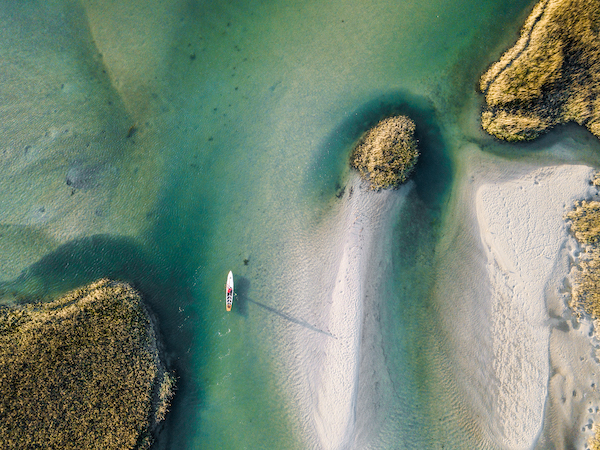A handful of leopard sharks swam languidly below me, my snorkeling mask becoming my observation window into their underwater world. The handful of pelagic swimmers quickly grew to two handfuls, and the next thing I knew, I was surrounded by leopards. No matter which way I turned my head, they were there in my viewfinder. Despite knowing of their passivity, I felt my blood pepper a little bit. My breathing quickened. Focusing on the colors and markings on their bodies as they glowed in the ocean-filtered sunlight had a calming effect on me as an example of the beauty found beneath the water’s surface in La Jolla, CA.
Since that time, I have had countless other opportunities of swimming, body surfing, kayaking and snorkeling in La Jolla. It is a wonderful spot on the map, one enjoyed by locals and thousands upon thousands of tourists every year. In addition to the leopard sharks, snorkeling with seals and sea lions in the La Jolla Cove, along with lobsters, garibaldis, sheep crabs, and feeding cormorants, to name a few other species, is possible thanks to the vision and efforts of many people along the way for nearly a century. Looking closely at a map, one can see there are names of marine protected ocean areas that are there.
In 1929, what is now titled the San Diego-Scripps Coastal State Marine Conservation Area was created. Adjacent to it on the south side is the Matlahuayl State Marine Reserve, which was created in 1970 and was then called the San Diego-La Jolla Underwater Park Ecological Reserve, a name by which many people still refer to it today. A little further south are two more protected areas that were designated in 2012: the South La Jolla State Marine Reserve and the South La Jolla State Marine Conservation Area. In total, some 10 square miles of the ocean, from its surface to its floor, and four different kinds of habitats - flat/sandy bottoms, rocky reefs, kelp beds/forests, and submarine canyon - are all protected areas.
There are few places along the California coast where you can snorkel and scuba dive in conditions that can reach upwards of fifty feet of visibility. La Jolla is one of them. Also, you can surf at La Jolla Shores, SUP along the coastline, and open ocean swim from The Cove to the Marine Room (a local restaurant), if you want. Kayaking is possible from the shores, most people venturing in the direction of the sea caves. This is all to say that, without a doubt, it is an ocean sports destination.
In addition to the possible experiences one can have in La Jolla, there are other considerations when thinking about establishing protected marine areas. One of the first things that come to mind is tourism. It is certain that part of the reason people from all over the world visit the area is to see marine life, and if you are not in the water, you will still see it. Sea lions call the Cove and its environs home and a little ways away, the Children’s Pool is where you go to see the harbor seals. Aquatic bird life is perched on the cliffs, mostly cormorants and brown pelicans, and it flies by overhead. Dolphins swim past and if you are lucky, you might see whales migrating in the far distance.
However, when it comes to the sea lions and humans interacting, lifeguards have a challenge. If people get too close to the pinnipeds, the lions can be quite aggressive, and you suddenly have a dangerous safety situation. In fact, this past year, a portion of the point by the Cove was shut down, meaning no one is allowed onto the cliffs, public safety and marine mammal protection being the reasons. To be frank, some people made some unwise decisions in trying to get a photo.
What is more, when it comes to the sea lions and their swelling population in and around the Cove, the odor of their fecal matter emanating off the cliffs is a huge challenge to local businesses, especially those in the food and drink industry. Monies spent to neutralize the odor have not worked, and some people suggest that the sea lions have too much leeway and that human livelihoods should take precedence. It is an ongoing battle, one that likely will see no end.
As with any protected area, human impact is one of the biggest challenges. In peak season, La Jolla can be inundated with beach goers and what locals call an armada of kayakers. Snorkeling in the Cove can be an exercise in trying not to bump into humans. People stand on the reef and collect rocks and shells, which are prohibited. Lifeguards on the loudspeaker warn people of their wrong doing and I've seen them write citations for violations. Resource management plays out live, if you closely watch.
All of this demonstrates the delicate balance of managing marine protected areas for what they are to be, while permitting humans access to experience them. It is a great challenge, to say the least. In addition, La Jolla is unique in that it is home to the Scripps Institute of Oceanography at the University of California San Diego, where some of the world’s leading marine/ocean research programs have existed since 1903. Much needed science is conducted here, including climate change impact on protected areas.
Back in the water, I swam away from the leopard sharks, snorkel-in-mouth and sweeping fins on my feet. I decided to venture over towards the sea caves. I like to wander while snorkeling, getting into a rhythm that becomes like meditation. Along the way I saw stingrays here and there, sea bass, and juvenile garibaldis with iridescent blue-purple spots on their backs. The highlights, though, were my first sightings of a shovelnose guitarfish and a fairly good-sized bat ray. The excitement I felt reminded me of one of my first scuba experiences in the Bay Islands of Honduras and seeing a giant spotted eagle ray that had a 6-foot wingspan. Wonder and awe at the mystery of their lives was what I was feeling, as well as gratitude to be able to see and watch them in their home.
When I moved to San Diego eleven years ago, I had no idea how good the snorkeling was. To be honest, I did not even think of snorkeling at all, but it has now become a regular part of my life. I anticipate and look forward to the return of the leopard sharks and take comfort in knowing they will be there. It is considered to be one of the largest annual gathering sites of leopard sharks in the world. La Jolla is their breeding and nursing ground, it is their home, and more than anything else, I am thankful to the people who protect that home by establishing marine protected areas.







